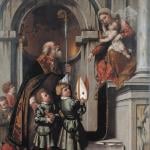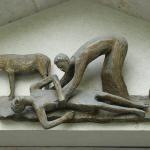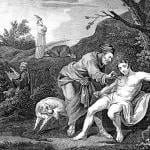To the surprise of many, even in the beginning of the scholastic movement, the schoolmen would often discuss the possibility of that there could be other intelligent forms of life in the universe than our own. They thought it was an important question, one worthy of investigation. “Since once of the most wondrous and noble questions in Nature is whether there is one world or many, a question that the human mind desires to understand per se, it seems desirable for us to inquire about it.”[1]
While a few accepted the possibility that there could be such life, they all believed it was unlikely that such beings existed, mostly because of their cosmological understanding. Their reasoning was based upon a misunderstanding of the universe, its size, and formation. For most, the world we lived on was the center of the universe, and matter was seen to naturally incline itself to the earth so that the only possible material world was ours, and so the only place where life could exist was what was seen on earth and what was seen in the heavens. Since no such intelligent life, beyond our own, was found on the earth, it seemed evident it did not exist.[2] Of course, they accepted the possibility that celestial entities, such as stars, were living creatures, and so they could possess intelligence. As Marie George points out,[3] the following quote of St Thomas Aquinas shows that he thought they did not, but he said one could believe they did without contradicting the faith:
In Aristotle’s view, then, the heaven is compared of an intellectual soul and a body. He indicates this when he says in De anima II that “in certain things there is intellect and power of understanding, for example, in men, and in other things like man or superior to him,” namely, the heaven.
[…]
As for the heaven being animate, we have spoken of this not as though asserting its according with the teaching of the faith, to which the whole question is entirely irrelevant. Hence, Augustine says in the Enchiridion: “Now is it certain, to my mind, whether the sun, moon, and all the stars belong to the same community, namely, that of the angels; although to some they appear to be luminous bodies devoid of sense or intelligence.”[4]
Marie George also explains why there is no concern here: “One reason why Aquinas does not think the ET existence is of concern for the faith is that the faith and Sacred Scripture are ordered to our salvation, and not to instructing us in cosmology or science in general. It is for this reason that Scripture sometimes omits mention of certain things, as happens, for example, in the Book of Genesis in regard to the creation of angels.”[5]
This point perhaps is more important for us today than in the time of Aquinas, because of the changes in science which we have seen, leading us to be quite different in cosmological understanding than the authors of Scripture or the Church Fathers. We must understand the orientation of the dogmas and doctrines of the faith as well as their limitations; this will prevent us from getting over-burdened with literalistic readings of Scripture and the Fathers which would, in the end, lead us to abandon the faith when science demonstrates conclusively something which contradicts the cosmology of Scripture. It also opens us up to greater theological investigation, to raising old questions anew, such as the question of intelligent life in the universe, because of the change of cosmology without disputing the value of tradition.
Indeed, the schoolmen would soon see this happened; when Etienne Tempier included the denial that God could have made a plurality of worlds as one of the errors of scholasticism, scholastics responded and agreed with him, creating the foundation for later theological discourse on other worlds. As Stephen Dick relates, “At Paris Godfrey of Fontaine, Henry of Ghent, and Richard of Middleton held that a plurality of worlds was not theologically impossible; at Oxford William of Ware, Jean of Bassols, and Thomas Strassbourg made the same claim. […] They were also the first to hold that God could create other worlds, and that every possible world could determine the natural motions of its own bodies, whether those bodies were different in form from those of our world or the same. Moreover, they held that God could create matter for another world ex nihilo.”[6]
The Copernican revolution would revise our cosmology, and allow us to raise the question of intelligent life anew. We were no longer limited to the earth for our investigation. Of course, we can trace this notion back before Copernicus, to Nicholas of Cusa, whose own scientific, mathematical, philosophical and theological reasoning led him to believe not only in an enormous (non-finite) universe, but one which was full of life. “Therefore, just as the earth is not the center of the world, so the sphere of fixed stars is not its circumference – although when we compare the earth with the sky, the former seems to be nearer to the center, and the latter nearer to the circumference. Therefore, the earth is not the center either of the eighth sphere or of any other sphere.”[7] After pointing out that the earth could be said to be a “star,” showing the term was used for planets as well as what we call stars, Nicholas discusses, without any question, life on other worlds:
Therefore, the inhabitants of other stars – of whatever sort these inhabitants might be – bear no comparative relationship to the inhabitants of the earth (istius mundi). |This is true| even if, with respect to the goal of the universe, that entire region bears to this entire region a certain comparative relationship which is hidden to us – so that in this way the inhabitants of this earth or region bear, through the medium of the whole region, a certain mutual relationship to those other inhabitants. […]
Hence, since the entire region is unknown to us, those inhabitants remain unknown.[8]
It would be only later when, because the remote nature of these forms of life, they could not be known, the question of their salvation was raised. Philip Melanchthon, for example, rejected the notion entirely based upon his understanding of the incarnation:
We know God is a citizen of the world with us, custodian and serving this world, ruling the motion of the heavens, guiding the constellations, making this earth fruitful, and indeed, watching over us; we do not contrive to have him in another world, and to watch over other men also . . . the Son of God is One; our master Jesus Christ was born, died and resurrected in this world. Nor does he manifest Himself elsewhere, nor elsewhere has He died or resurrection. Therefore it must not be imagined that Christ died and was resurrected more often, nor must it be thought that in any other world without the knowledge of the Son of God, that men would be restored to eternal life.[9]
The crux of the matter, so to speak, was the incarnation; if there were other worlds, did it mean God would have to incarnate and die for them as well? Would it not be absurd to suggest this? But if he did not do so, he would they be saved? Would God create such intelligent beings who could not be saved? For this reason, many people, following Melanchthon, have suggested no such creatures could exist.
The problem with this line of reasoning is that it fails to understand the cosmic value of the incarnation. The work of Christ is for the whole of creation, and not just humanity. Paul in Romans implies this: “For the creation waits with eager longing for the revealing of the sons of God; for the creation was subjected to futility, not of its own will but by the will of him who subjected it in hope; because the creation itself will be set free from its bondage to decay and obtain the glorious liberty of the children of God. We know that the whole creation has been groaning in travail together until now; and not only the creation, but we ourselves, who have the first fruits of the Spirit, groan inwardly as we wait for adoption as sons, the redemption of our bodies. For in this hope we were saved. Now hope that is seen is not hope. For who hopes for what he sees? But if we hope for what we do not see, we wait for it with patience” (Rom 8:19 -25). Church Fathers, such as St Gregory the Theologian, continued with this cosmic theme and wrote on the universal effects of Christ’s passion.[10] One could even follow St Athanasius’ famous dictum “God became man so that man can become God,” and change “man” with “creature” and one would see the universal effects of the incarnation. For it is obvious if God became man, he also became a creature. There is no soteriological difficulty if one follows the cosmic understanding of Christ found within some Scriptural passages and many patristic authors.
This does not mean there is no practical difficulty. The question, which cannot be answered by us with what we presently know, is how these creatures would learn of Christ to be saved by him. Yet, just as we know that those who do not explicitly know Christ can be saved by him (as long as they do not implicitly reject him, nor explicitly reject him when they properly understand the Christian message), so we can say that their salvation rests in God’s hands. It would still be through Christ, even if they do not explicitly know of the incarnation. Or God could have given them a means to know of the incarnation: the Holy Spirit is active and blows as it wills; perhaps the Holy Spirit is revealing the truth of Christ to the cosmos.
Nonetheless, even if there is no essential reason for there to be multiple incarnations, does that mean there cannot be such? Marie George brought out in her examination of St Thomas Aquinas, Aquinas had no problem with multiple-incarnations for God[11]:
What has power for one thing, and no more, has a power limited to one. Now the power of a Divine Person is infinite, nor can it be limited by any created thing. Hence it may not be said that a Divine Person so assumed one human nature as to be unable to assume another. For it would seem to follow from this that the Personality of the Divine Nature was so comprehended by one human nature as to be unable to assume another to its Personality; and this is impossible, for the Uncreated cannot be comprehended by any creature. Hence it is plain that, whether we consider the Divine Person in regard to His power, which is the principle of the union, or in regard to His Personality, which is the term of the union, it has to be said that the Divine Person, over and beyond the human nature which He has assumed, can assume another distinct human nature.[12]
There are a few things which must be said about this passage. It is, to be sure, rather strange; how can there be many “human natures” if there is only one which is shared by all humanity? We must think of this in relation to what was understand by the term “human” in this era: a rational animal. If we think of it in this way, the assumption of multiple “human natures” is makes sense; it is then the question of whether or not God can assume the nature of a multitude of rational creatures. Aquinas here says yes.
Now, in saying this, we must make sure we do not state that one incarnation is lost, that one body is discarded, if God assumed another nature. The incarnation is eternal, and what is assumed by God remains assumed (otherwise the point of the assumption would be lost, and we would not receive the benefits from it). If God were to assume the nature of other rational creatures, would this mean that God has taken on a multitude of bodies? When we get to heaven, will we see God billions of forms, all speaking to us at once? This seems rather unlikely, and would suggest a practical limitation to this idea. Or does it?
C.S. Lewis in his Narnia series has provided to us a different way to understand the question. Here we see the Son of God has incarnated himself in the form of a lion. In Narnia, it is his form, that of the king of beasts. The children who came to help Narnia saw him as Aslan, but also learned that it was not his only form – in our world, of course, it is that of the God-man Jesus Christ. Because the form Aslan was known in Narnia was that of a lion, the children saw him, with the rest of the Narnians, as a lion. Yet, at the end of The Last Battle Lewis tells us that, after the end of Narnia, in the afterlife, the children were to see him in a new form: “And as he spoke He no longer looked to them like a lion; but things that begin to happen after that were so great and beautiful that I cannot write them down.”[13] This occurred only after they found Narnia and our world were joined together in the eschaton, so that the two, and other worlds, merged in eternity.[14] What we have here is multiple incarnations, where one experiences the form of the Son of God according to their disposition and expectations: for Narnians, they see him as a lion, for humans, they see him as Christ.
Here we have a way to understand multiple incarnations without the need for a multitude of bodies. The incarnation can be experienced and seen differently, even though it is one and the same body which is being encountered. The normal way to see him would be according to one’s nature, though other factors could change that experience, so that one could see him and encounter him in other forms.[15] Understanding this will also help us appreciate the eucharist, which gives us Christ in the form of bread (though no longer of the nature of bread, so there is a distinction here which must not be left unacknowledged).
What is being said here is that our own experiences, past, and means by which we interpret the world, the construction of the world we create for ourselves, becomes the means by which we interpret and understand the incarnate God. We can be freed from such constructions, and see him in other, greater forms, once we are open to them through his grace – the transfiguration, for example, was one such manifestation for Peter, James and John.
We find here an affirmation of a principle in Yogācāra Buddhism, with its understanding that one’s experience of the Buddha comes from one’s level of spiritual awareness.[16] While there are other ways this is expressed, in general, it is understood that a Buddha can be experienced in one of three ways, in one of three “bodies”: the nirmanakaya or the historical, normative form; the sambhogakaya, or the form of glory; and finally, the dharmakaya, or the truth body, the real, and ultimate, form of the Buddha. According to Asanga, “The unlimited metamorphosis of Buddhas, is known as the nairmānikāya (metamorphic).”[17] In the commentary, generally attributed to Vasubandhu, it is said that “The nairmānika kāya of the Buddha, is the metamorphosis of the Buddha, who has unlimited aspects.”[18] That is, the Buddha could possess, and does possess, an unlimited number of forms in which he can be seen and experienced in the concrete world, while the form of his blessedness transcends those constructed, historical forms, and his essential form surpasses even that of his glory, and is free from all construction and taints. Now from a Christian standpoint, we can even understand there is truth in this even for ourselves: who we are in history will be different from who we are in glory, and who we are in glory rests upon the essential nature of ourselves as comes to us from God (our logos rests in the Logos). But if this is true for us, it can also give us a glimpse in the truth of this with the incarnate-person, God the Son. As truly being without peer and unlimited in power, the historical form could be seen and experienced in a multitude of ways, according to a multitude of incarnations, all leading to the one and same person behind it all.[19] Yogācāra Buddhism would tell us that how we experience the person of the Buddha is dependent upon our own level of spiritual preparedness; Christianity would add that, while this probably is true, God’s grace would be able to supplement to us what is needed if and when God desires to show us himself in different forms and we have not purified ourselves and our minds enough to experience that form yet (be it his historical human form, his form in glory, or the beatitific vision; or, if we accept the possibility of multiple incarnations, in his non-human incarnate form, or the form of that non-human incarnate form in glory).[20]
But if we are talking about the possibility of multiple incarnations, this also opens us up to more dialogue with Hinduism and its understanding that the ultimate One (depending upon the tradition, this could be Shiva, Vishnu, Kali, or someone else), has eternal existence, creates the world and world history, and incarnates himself or herself into it as many times as necessary to keep it in proper order. For example, those who worship Vishnu see him as incarnating as a fish, as a tortoise, as a boar, as a man-lion, as a dwarf, as “the angry man,” as Rama, as Balarama, as Krishna, and in the end, as Kalki. What would differentiate Christianity from Hinduism is in the reality of the incarnation itself; for Hinduism, it is more docetical, while for Christianity, any incarnation would be real, definitive, and eternal. But, as with Buddhism, there is a sense that an aspect of the Gospel, perhaps an aspect we have not yet picked up on, is being prepared for us through the Hindu tradition, and its proclamation of multiple incarnations. Buddhism explains well how we would experience the form of one who might have multiple incarnations, providing the means by which Lewis’ Narnia is explicable; Hinduism, in its affirmation of theism, provides us the other key in a way which negates the weakness of Buddhism’s non-theism. Combine the two together, with Lewis’ inclinations, and we have a means by which we can understand and appreciate how multiple incarnations could be experienced, thereby giving strength to St Thomas Aquinas’ position, where he describes the multiple incarnations in this manner:
Consequently, in order to judge of a word’s signification or co-signification, we must consider the things which are around us, in which a word derived from someform is never used in the plural unless there are several supposita. For a man who has on two garments is not said to be “two persons clothed,” but “one clothed with two garments”; and whoever has two qualities is designated in the singular as “such by reason of the two qualities.” Now the assumed nature is, as it were, a garment, although this similitude does not fit at all points, as has been said above (2, 6, ad 1). And hence, if the Divine Person were to assume two human natures, He would be called, on account of the unity of suppositum, one man having two human natures.[21]
If there are multiple incarnations, it would be as “one person clothed with multiple garments,” but the garment which we see and experience would be based upon the spiritual and mental condition we bring to us in that meeting. For most of us, that would mean, Christ as human, or Christ glorified in his humanity; but, if we encounter and find other forms of intelligent life, we might find ourselves open to, and experiencing, Christ in those forms as well.
Footnotes
[1] St Albertus Magnus, Alberti Magni opera omnia (Aschendorff, 1971), vol. V. pt. 1., p. 55 quoted in and translated by Steven J. Dick, Plurality of Worlds: The Origins of the Extraterrestrial Debate from Democritus to Kant (Cambridge: Cambridge University Press, 1984), 23.
[2] See ibid., 23-28.
[3] See Marie I. George, “Aquinas on Intelligent Extra-Terrestrial Life,” in The Thomist 65 (2001): 250.
[4] St Thomas Aquinas, Summa Contra Gentiles II: Creation. Trans. James F. Anderson (Notre Dame: University of Notre Dame Press, 1975), c.70 ¶ 3, 7.
[5] George, “Aquinas on Intelligent Extra-Terrestrial Life,” 250
[6] Dick, Plurality of Worlds, 28-9.
[7] Nicholas of Cusa, On Learned Ignorance. Trans. Jasper Hopkins (Minneapolis: The Arthur J. Banning Press, 1990), b. II, c.11, ¶ 157. Nicholas writes further on this all to show the enormous size of the universe and that God is the center and circumference of all things.
[8] Ibid., b. II, c. 12, ¶ 170 -1.
[9] Philip Melanchthon, Initia doctrinae physicae (Wittenberg, 1550), fol. 43 quoted and translated in Dick, Plurality of Worlds, 89.
[10] In Sermon 39.13 he wrote, “And natures are instituted afresh, and God becomes man,” leading to an investigation on this very topic by St Maximus the Confessor in Amb. 41. See Andrew Louth, Maximus the Confessor (London: Routledge, 1996), 156 – 162.
[11] See George, “Aquinas on Extra-terrestrial life,” 252.
[12] St Thomas Aquinas, Summa Theologica. Trans. Fathers of the English Dominican Province (New York: Benziger Bros. edition, 1947), III, q.3, a.7.
[13] C.S. Lewis, The Last Battle (New York: Macmillan Publishing Company, 1978), 183-4.
[14] See ibid., 181-2.
[15] This could also explain the encounter with Christ on the road to Emmaus (cf. Luke 24:13 -34).
[16] From a Christian perspective, all we need to say is that Yogācāra was onto an important principle, but can only come to its own and show its full value with Christ.
[17] Asanga, Mahāyānasūtrālamkāra. Trans. Surekha Vija Limaye (Delhi: Sri Satguru Publications, 2000), 136.
[18] Ibid., 136.
[19] Of course, this is not an issue of necessity. God does not need to do this, but it would seem, if there are a multitude of worlds, this would be more fitting, to give all worlds access to the Son, the incarnate one, than to require them only to have an implicit relationship with him. Until if and when we encounter such life, however, this must remain on the level of theological speculation, and is liable to be modified and corrected as need be.
[20] And all such purification would itself be a result of grace, though of course, a result of one’s cooperation with grace.
[21] St Thomas Aquinas, Summa Theologica. III, q.3, a.7.












